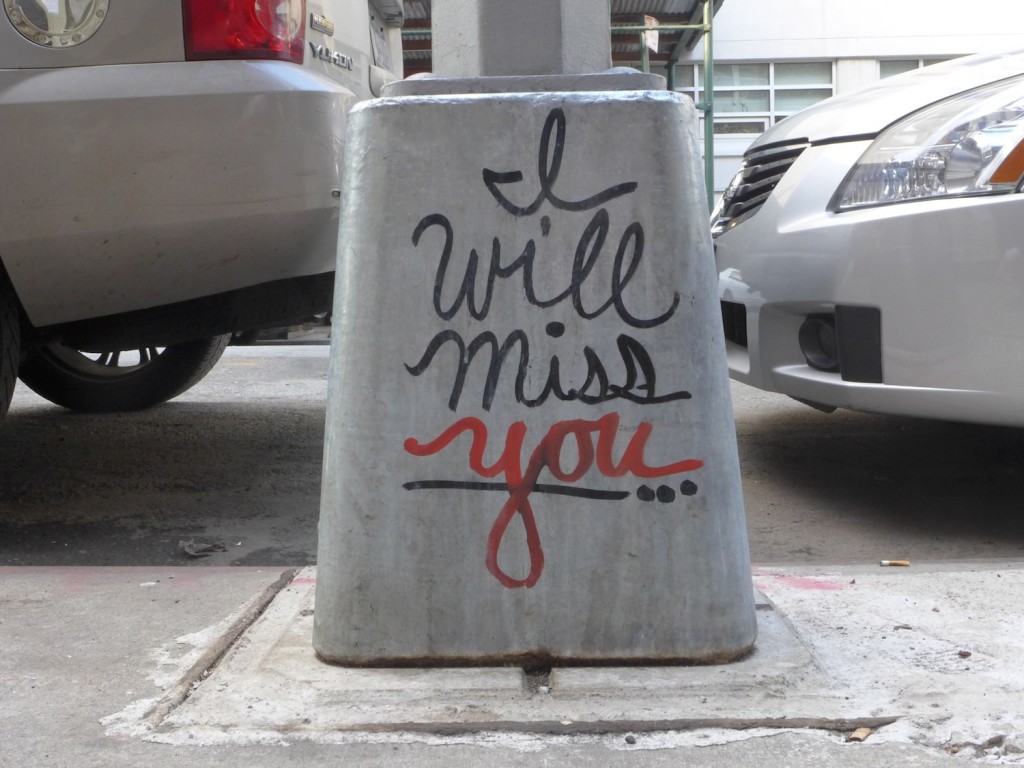 Returning to Berlin after an absence of two and half months early on Monday was quite a shock and I have to admit that I still miss New York, as this piece of graffiti I captured on East 7th Street a couple of days before my departure said I would. But, of course, it’s way easier for me to taste the full gamut of German, Austrian, Alsatian and other European Rieslings here than in the USA (where many of them are not imported or only reach a few states, and not always New York).
Returning to Berlin after an absence of two and half months early on Monday was quite a shock and I have to admit that I still miss New York, as this piece of graffiti I captured on East 7th Street a couple of days before my departure said I would. But, of course, it’s way easier for me to taste the full gamut of German, Austrian, Alsatian and other European Rieslings here than in the USA (where many of them are not imported or only reach a few states, and not always New York).
My re-immersion in those wines abruptly made me aware of the fact that today the cliché of “New World” Riesling being lower in acidity than “Old World” Riesling has nothing to do with the contemporary reality. Climate change has made the whole range of European Rieslings less acidic and they are now generally lower in acidity than American Rieslings. That applies no less to wines like those from Anderson Valley in Mendocino County/California, than those from the Willamette Valley in Oregon, or the Finger Lakes in Upstate New York. During my two and a half months in North America I visited those and bunch of other regions where Riesling is grown. The most acidic wines I tasted were those from the Okanagan Valley, which probably has the warmest summer weather of anywhere in Canada. But in wines like those from Tantalus Vineyards and 8th Generation in Kelowna acidities for which the analytic figures sounded terrifying tasted fantastic. So the high acidity of North American Rieslings are not fundamentally a problem, though they do challenge winemakers to achieve a satisfying balance.
Yesterday evening I met up with Gerrit Walter, a 26 year old winemaker from the Mosel (pictured above) who I met at the famous wine school in Geisenheim/Rheingau when I was a guest student there back in 2008-9. At the Weinstein wine bar – one of the world’s best Riesling bars! – I tasted his dry 2012 Weissburgunder (Pinot Blanc) and several of his dry 2012 Rieslings. Since I last tasted them back in the spring these wines have all developed really well. The basic 2012 Riesling trocken, what we call call “Gutsriesling” here in Germany is a spectacular vibrant wine with yellow apple and white peach aromas for its price, just Euro 6.50 for private customers direct from Weingut Walter in Briedel on the Mosel. It weighs in at a moderate 12% alcohol and is properly dry.
“Biredel???” I can already hear some of you asking incredulously, and I admit this is one of the least well-known wine growing communes on the Mosel. For the purpose of orientation Briedel’s the next village downstream from Pünderich home to the famous Clemens Busch estate, but frankly just 15 years ago few people outside Germany had ever heard of Clemens Busch or Pünderich. The wine map of Germany has changed dramatically during that time and will continue to change during the years to come, so I suggest that you try and memorize Briedel now, rather than get left behind the rest of the wine scene. If you doubt that this is really worth the effort, then taste Gerrit Walter’s rich, juicy and complex 2012 Briedeler Riesling feinherb.
PS My book writing progresses well, but has also distracted me from this blog. Sorry!


![120114_riesling_global_RZ [1600x1200]](http://www.stuartpigott.de/wp-content/uploads/2013/08/120114_riesling_global_RZ-1600x12002.jpg)